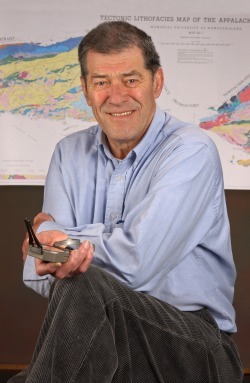Late Earth Sciences professor to be inducted in the Canadian Mining Hall of Fame

This January, the late Dr. Harold (Hank) Williams, of the Department of Earth Sciences, will be inducted into the Canadian Mining Hall of Fame.
The Hall of Fame “recognizes and honours the legendary mine finders and builders of a great Canadian industry.” Candidates are individuals who have demonstrated outstanding lifetime achievements to the benefit of the Canadian or world mineral industry in the areas of exploration, corporation building, technical or supporting contributions, or mining in society.
Born and raised on ‘The Rock’, the island of Newfoundland inspired Dr. Williams during his fruitful years with the Geological Survey of Canada (GSC) and prolific career at Memorial University of Newfoundland and Labrador in St. John’s.
A GSC mapping program on the island led to his seminal 1964 paper, The Appalachians in Northeastern Newfoundland: A Two-Sided Symmetrical System, which advanced the ground-breaking concept of plate tectonics for the first time. His landmark paper and 1967 geological compilation map of Newfoundland represented the first on-land syntheses of an orogenic belt in a tectonic framework. They were also keystones to J. Tuzo Wilson's recognition of the concept of an opening and closing proto-Atlantic (Iapetus) Ocean.
Dr. Williams continued his work at Memorial to international acclaim. One of his greatest achievements was a tectonic lithofacies map of the entire North American Appalachian mountain chain from Alabama to Newfoundland, which interpreted terrane divisions across the Atlantic. It was a gargantuan feat and a best seller when it was released in 1978, with 10,000 copies sold worldwide.
The map provided a regional framework for geologists to focus their search for specific types of deposits, which led to discoveries such as the Duck Pond mine in central Newfoundland. The implications for mineral exploration were exciting, and plate tectonics, once hotly debated, became widely accepted around the world as Dr. Williams helped establish this unifying theory for the drift of continents, the evolution of mountain belts and the formation of related mineral deposit types within mountain belts.
Dr. Williams also inspired a generation of geologists and helped establish Memorial as a leader in earth science research. One of the youngest fellows of the Royal Society of Canada when he was inducted in 1972, he also received many other awards, including the Logan Medal of the Geological Association of Canada.
“This is a very rare accolade and only given to a few,” said Dr. Stephen Piercey, a professor with the Earth Sciences department. “The nomination was spearheaded by Frank Blackwood, a Memorial alumnus; Peter Dimmell, and myself, with immense support from numerous letter writers from industry, government, and universities.”
“It’s recognition of a colleague who has made immense contributions to global geoscience and it’s great to see him recognized posthumously.”
The induction will happen Jan. 14, 2016 at the annual Canadian Mining Hall of Fame dinner in Toronto.
Established in 1988, the Hall currently has over 160 members and sponsors include the Canadian Institute of Mining, Metallurgy and Petroleum, the Mining Association of Canada, the Prospectors and Developers Association of Canada and the Northern Miner newspaper.